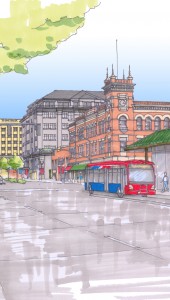
The Provo City Council continued to voice support for the Bus Rapid Transit (BRT) project in its May 6 meeting.
After spending nearly three hours discussing the proposed BRT route and listening to research and opinions of Provo residents, the Provo City Council decided to discuss the matter further in its June meeting.
The BRT route has been discussed for several years as a way to provide BYU and UVU students with cheap, convenient transportation. Hales Engineering research claims the BRT could take up to 5,000 cars off the road and transport 13,000 riders a day.
Brian Hales, from Hales Engineering, said, “BYU Bus ridership has been declining. A UTA pass is $63 per month, which is higher than it used to be.” The hope of the BRT project is to make public transportation more affordable for college students, many of whom do not have cars and are not willing to pay high prices for public transportation.
The route will connect the Orem Intermodal Center, UVU, the University Mall, BYU, student housing areas, downtown Provo, the Provo Intermodal Center, the Provo Towne Centre Mall and the East Bay Business Park in a 38-minute trip.
Jennifer Stout, a graphic design major from Hyrum, Georgia, has been a UVU student living on BYU off-campus housing for a year now. After selling her car, she struggled with learning the ins and outs of the current public transportation system.
“I would totally use the BRT every day if it was an option,” Stout said. “It was a huge hassle to drive to UVU in traffic every morning, and navigating the complicated bus routes isn’t much better.”
Stout is one of many UVU students living in BYU off-campus housing who would benefit from the BRT. The BRT would also provide easy transportation to both the Orem and the Provo Frontrunner Train Stations. For students who often need to get to and from the Salt Lake City Airport, this provides a convenient way to travel.
Although there are many Provo residents and students like Stout who support the BRT project, others are more hesitant to accept it. During the meeting, several Provo residents expressed concern about the route the bus would take.
“One of the things that has concerned me throughout this whole process is the impact of a 60-foot-long bus passing by an elementary school every five minutes,” said resident David Armond.
The proposed Route 4 the BRT would take could potentially bring more traffic near Wasatch Elementary School on 900 East. To alleviate this concern, part of the BRT budget will go to funding for traffic-calming measures on 900 East, noise reductions and circular drives for frontage homes facing 900 East and safety mitigation for Wasatch Elementary School.
According to UTA documents, the BRT project is estimated to cost $150 million, with $75 million coming from the Federal Transit Administration. The other $75 million is expected to come from local taxes.




